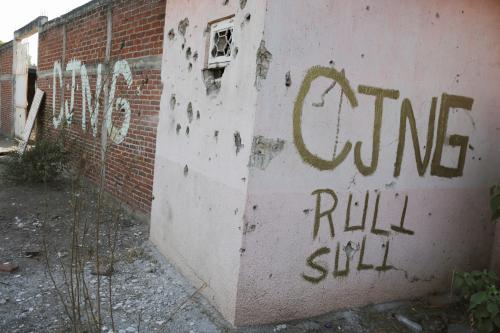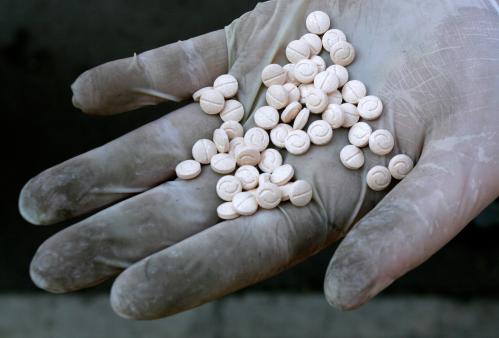On April 1, the Biden administration released a statement of drug policy priorities for its first year. There is much to like: To an unprecedented degree, the strategy embraces much of what the drug policy reform community has been recommending for decades. It strongly focuses on drug treatment and prevention and — in a major break with the past — even harm reduction, long anathema to official policy. It promises to learn from experience, including the limits of existing treatment, prevention, and harm reduction efforts. These new policy directions deserve to be robustly funded and implemented.
But supply-side measures may actually become the biggest drug-related headache for the Biden administration. The U.S. government has highlighted four countries for counter-drug collaboration: China, India, Colombia, and Mexico. In Mexico, as I’ve detailed, the Andrés Manuel López Obrador administration sabotaged security and counter-drug cooperation. Washington must go beyond merely focusing on drug treatment and prevention in collaboration with Mexico: For the sake of U.S. lives and human security, rule of law, and democracy in Mexico, the United States must insist that the López Obrador administration start taking on drug trafficking groups in smart ways, instead of yielding to their corruption and coercion.
What are the challenges in collaborating with China, India, and Colombia on counter-drug efforts?
The strategic drug policy guidance
The United States continues to reel from an unrelenting drug epidemic, with overdose deaths in 2020 likely topping 90,000, in a new record. Opioids, particularly synthetic ones such as fentanyl, still account for a preponderant number of the overdoses. They are increasingly mixed into other drugs, such as cocaine and methamphetamines, with the latter surging in 2020 in U.S. drug use. In March, President Joe Biden signed the American Rescue Plan appropriating nearly $4 billion for expanding drug treatment, prevention, and harm reduction. The president has also stated that people should not be incarcerated for drug use and instead be offered treatment; and he emphasized the related need to eliminate racial, economic, and gender inequities from the criminal justice system.
The emphasis on treatment, prevention, and harm reduction dominates the administration’s new drug policy plan. Of seven priorities, reducing the supply of illicit drugs is just one, in addition to:
- Expanding access to evidence-based treatment;
- Advancing racial equity in U.S. drug policy;
- Enhancing evidence-based harm-reduction efforts;
- Supporting evidence-based prevention efforts;
- Advancing recovery-ready workplaces and expanding the addiction workforce; and
- Expanding access to recovery support services.
In terms of supply reduction, the plan details six primary lines of effort, two of which are 1) working with key partners in the Western Hemisphere, like Mexico and Colombia, and 2) engaging China and India, and other source countries, to disrupt the flow of synthetic drugs and their precursors. Significantly, the section on working with partners in the Western Hemisphere emphasizes a comprehensive response — deepening bilateral cooperation on public health approaches, expanding effective state presence, developing infrastructure, and ensuring respect for the rule of law and human rights in drug policy responses.
Those directives are music to the ears of many drug policy reformers, and to me. But collaborating with China, India, Colombia, and Mexico will be difficult. Each country poses a different challenge, and in each place, this counter-drug agenda intersects differently with geopolitics or domestic and regional issues.
China
Over the past decade, China has dominated the supply of fentanyl and other synthetic opioids and their precursors to the United States. Much of the U.S. policy response has thus centered on getting China to regulate its free-wheeling synthetic opioid production and uninhibited sales of illicit drugs to the United States. Although illegal in the United States, such exports were nonetheless often legal in China until May 2019 when, under U.S. pressure, China “scheduled” the sales of fentanyl analogues, making their production, sale, and export legal only when accompanied by government licenses. To some extent, China also intensified enforcement of the new regulations, such as the screening of mail parcels from China to the United States.
Yet China has not adopted similar controls on the precursor agents for fentanyl or methamphetamine. Both continue to flow from China without hindrance, heading into Southeast Asia and Mexico, where Mexican drug trafficking organizations cook the precursor chemicals into fentanyl and meth. Most of the fentanyl now arriving into the United States comes through Mexico. Synthetic opioids are also still shipped by mail, but now much more within the United States, often sent from post offices close to the Southwest border after having been trafficked into the United States. Meanwhile, Chinese smuggling rings have moved their front companies to the dark web.
Getting China to collaborate further with the United States on cracking down on precursor agents will not be easy. On the one hand, China has repeatedly signaled that it sees drug policy as one of the few possible areas of cooperation with the United States amidst the increasing geopolitical rivalry between the two countries. China also prides itself on being one of the world’s leading drug cops, even as it denies its role in the U.S. drug policy epidemic. On the other hand, however, China has often treated precursor agent control with little interest, blaming transshipment countries, such as Mexico, for their inadequate port controls. China has also refused to grant requests from the U.S. Drug Enforcement Administration to open offices in Guangzhou and Shanghai, key drug production and smuggling hubs in China. Chinese nationals designated drug kingpins by the U.S. Department of Treasury’s Office of Foreign Asset Control remain at large.
India
Even as the United States and India seek a closer strategic partnership, their cooperation on drug policy control may be even more fraught than the U.S. drug control relationship with China. After years of reluctance around how close to get to the United States, and seeking a more neutral non-aligned role even vis-à-vis China, the China-India border tensions of 2020 have pushed New Delhi closer to Washington. To contain China and counter its aggressive moves in the Indo-Pacific, the United States has sought for years to build a coalition among the United States, Japan, Australia, and India. For years, India was the most reluctant and meekest participant, but in late 2020 it joined naval exercises of the so-called Quadrilateral Security Dialogue (known as the “Quad”), tackling highly sensitive issues that India had previously refused to discuss, let alone collaborate on. In 2021, to counter China, the Quad cooperation has increasingly expanded beyond maritime security into issues such as cyber security, counterterrorism, critical technologies, and global diplomacy, including vaccine diplomacy.
Yet counternarcotics cooperation with India is bound to be a challenge. India’s powerful and large pharmaceutical industry is even more poorly regulated than China’s, and India’s government regulatory and enforcement controls are far weaker than China’s. Most licensed pharmaceutical companies are rarely inspected, allowing many unlicensed companies to operate. Enforcement of regulations is essentially nonexistent.
Like China, India is a massive source of methamphetamine and fentanyl precursor agents, regulating only some. For years, India has been even more reluctant to discuss and admit its role in precursor smuggling. And after new regulations came into effect in China, China’s traffickers began working with their Indian counterparts, including Indian pharmaceutical companies, to circumvent China’s new regulations and smuggle fentanyl and precursors to the United States.
India’s pharmaceutical companies have been completely indifferent to the effects of their export of industrial-potency tramadol (another type of opioid) throughout Africa, where a dangerous epidemic has emerged.
And like from China, various types of synthetic drugs are illicitly exported daily from India, including to the United States. Mexican drug trafficking organizations have also developed a network of suppliers of precursor or finished synthetic drugs in India.
Even as the United States courts India in the Quad, it can still demand meaningful cooperation on drug supply control. In fact, the China-India border tensions should boost U.S. resolve to elevate drug policy on the agenda with India bilaterally, and within Quad. Australia’s strong record on drug control policy, including with respect to meth flows from China, also makes the Quad an additional convenient multilateral forum to engage India on far stronger domestic and international regulation of its pharmaceutical industry, as well as enforcement of international laws and regulations regarding dependence-causing drugs and precursors.
Colombia
Even though Colombia has historically been the United States’ closest counter-drug partner in Latin America, the United States may also find it difficult to work with the Iván Duque Márquez administration. For years, the United States essentially force-fed drug crop eradication to Latin America, particularly to the Andean region and Mexico. As coca vastly expanded in Colombia from 2014 through 2017, the Trump administration demanded intensified eradication from Colombia under threat that it would be decertified, which would have disqualified it from U.S. aid unless the president issued a special national security exemption.
Yet, notably, the Biden administration’s drug plan does not mention the word “eradication” once — potentially signaling a radical break with past policies emphasizing eradication. Instead, it highlights state-building and human rights in drug policy, both of which can be in intense conflict with forced eradication.
The Duque administration, however, has embraced crop eradication, including through the resurrection of aerial spraying. It has long resented other components of the drug policy strategy it inherited from the Juan Manuel Santos administration as part of its peace deal with the leftist guerrillas of the Revolutionary Armed Forces of Colombia (FARC). In particular, it dislikes a so-called voluntary crop-substitution program that paid coca farmers up to two years of small income after the farmers destroyed all of their coca crops. Thus — along with the rural development program of key marginalized areas, the so-called Territorially Focused Development Plans — the voluntary crop-substitution program (already mis-designed and under-implemented by the Santos administration), has insufficient funding and other problems related to design and implementation. As a result, many coca producers who signed up for the voluntary eradication scheme have been — once again — left hanging without adequate support, and may easily sour on future government promises of alternative livelihoods. Intensifying insecurity in large parts of the country makes effective state-building even more difficult. Critically, like the Duque administration and all its predecessors, even the Santos government embraced the so-called zero-coca policy as Colombia’s key drug policy precept — and folly. The lynchpin demand is that a community eradicate all of its coca crops before it qualifies for any kind of alternative livelihood assistance. The problems arise not just out of eradication per se, but also the particularly badly sequenced eradication. That policy introduces myriad disastrous problems and has systematically undermined the effectiveness of alternative livelihoods in Colombia.
To put its policy implementation where its mouth is, the Biden administration should largely defund eradication policies in Colombia that happen before alternative livelihood efforts actually produce sufficient legal income. It should also not insist on, let alone fund, aerial spraying. Instead, it should concentrate its counter-drug cooperation on expanding security in Colombia, advancing and improving the stalled alternative livelihood efforts, and smartening up interdiction to improve human security in Colombia and throughout the Western Hemisphere, instead of undermining it.
Bumps ahead
The geopolitics of U.S. supply-side drug policies have changed, at a time when more Americans are using synthetic drugs. For the first time, U.S. lives and overdoses are linked to the U.S. principal strategic rival (China) and a country the United States courts as a key geopolitical partner (India). Along with the failures of prior counternarcotics policies, the shifts have changed the significance of Latin America in U.S. drug policy, allowing other issues — such as state-building, citizens’ security, democracy promotion, and human rights — to achieve greater prominence. But with neither China, India, Colombia, nor Mexico will Biden’s new drug strategy be easy.







Commentary
Biden takes a reformist drug strategy, but the challenge of supply countries remains
April 19, 2021